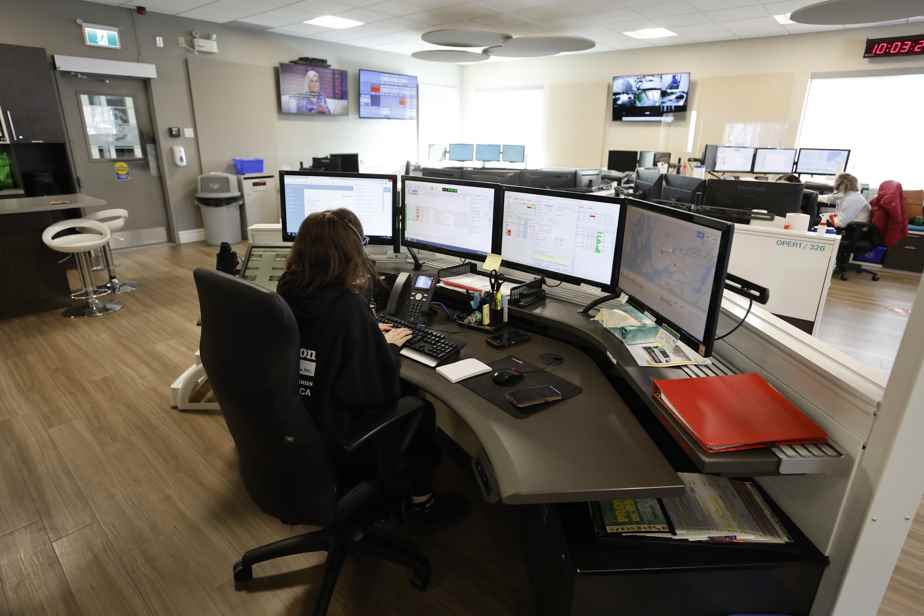In the premises of Alerte Santé, in Longueuil, nurse clinician Maude Dagenais sits in front of her computer. In front of her scrolls the real-time calls made to 911 for non-emergency health reasons. Its goal: to direct patients, if possible, elsewhere than to the emergency room or to invite them to go there without an ambulance.
10 a.m. An octogenarian calls 911 for orange-tinged diarrhea and weakness following recent bowel surgery. “Normally, with the antibiotics you take, it is not surprising to have diarrhea, but the orange color is not what we expect”, explains Maude Dagenais to his patient, after him asking some questions about his state of health.
For more information on her health file, Maude Dagenais suggests that the lady contact her pharmacist and then call her back. At the end of the line, the pharmacist confirms to the nurse that the orange tint is not normal. “Possibly there is blood in the stool,” she explains.
These possible bleedings are not to be taken lightly, considers Maude Dagenais, who recontacts her patient and advises her to go to the emergency room. “If it’s a bleed in your intestine, we don’t want to miss something that could become critical,” she says.

PHOTO MARTIN CHAMBERLAND, THE PRESS
Maude Dagenais, nurse clinician at Groupe Alerte Santé
Unclog emergencies
Before the implementation of the project in June 2021, a call to 911 for medical needs had only one possible service trajectory: the ambulance to the emergency room, regardless of the severity of the patient’s condition. Over the past year, of the calls assessed by these nurses, nearly 60% were directed to somewhere other than the emergency room or transported other than by ambulance.
At the end of the call, Maude Dagenais decides that she will not send an ambulance to her patient. Rather, she confirms with her that a member of her family is able to drive her to the emergency room. In 24 hours, she will call her back to check that she has arrived and that she is well.
Non-emergency health reasons occupy around 10 to 12% of the call center’s call volume. This new triage offers the possibility, if the situation allows it, to be referred to a clinic, home support or simply to receive advice on self-care.
Recently, a 90-year-old woman called 911 for her sick spouse, gives Maude Dagenais as an example. “We suspected flu-like symptoms, so I had COVID-19 tests delivered to their house,” she recalls.
The nurse assisted them remotely to do the test. “He was indeed a positive COVID-19 patient and he was able to stay at home. I followed up 24 hours later and he was already better. It allowed us to avoid a transport of paramedics, ”she rejoices.
Since the beginning of the project, more than 600 hours of ambulance transport have been saved. “We often manage to find other ways to transport them to the emergency room. For the older clientele, we use alternative transportation such as a taxi or adapted transportation offered by the CISSS Montérégie-Ouest,” says Claude Marie Hébert, head of the clinical division of the Alerte Santé group.
Place for teamwork
If a 911 call is considered a priority, the nurses do not triage it, and paramedics are sent directly to the scene. “If the paramedics arrive on site and realize that it is not urgent, they can call the nurses and perform a co-assessment of the patient’s situation,” explains Simon Jeanneau, paramedic ambulance technician and team leader at the Technicians’ Cooperative. paramedics of Montérégie (CETAM).
The paramedic then puts his phone on hands-free mode to have a discussion with the nurse and the patient, to determine an alternative to the emergency.
“At the beginning, some paramedics were apprehensive, because they feared that it would take longer to stay on the scene than to bring a patient to the hospital,” says Mr. Jeanneau.
We quickly realized that it is much better to spend 15 minutes with the patient than to wait 2 to 3 hours in the hospital.
Simon Jeanneau, team leader at the Cooperative of Ambulance Technicians of Montérégie
This joint assessment service between nurses and paramedics, a first in Quebec, is in place on the territory of the CISSS de la Montérégie-Ouest. It should be extended in the coming months to the whole of Montérégie.
Health Alert nurses are on duty from 7 a.m. to 11 p.m., Monday to Friday. The effects of their work are felt in the health network. « The head of the Suroît emergency department [à Salaberry-de-Valleyfield] told me that you can feel it when the regulation is not there, because there are ambulances that arrive with non-urgent cases that have not been filtered,” says Geneviève Demers, project manager for regulation at the CISSS of Montérégie-Ouest.
